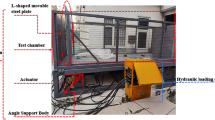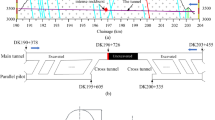Abstract
In this article, a series of model tests for a scaled high embankment, which is located at the Yun Gui railway, have been carried out. The purpose of the model tests was to ascertain failure modes of high embankments and the efficiency of the aseismic measures for buried strike-slip fault movement. The results show: (1) failure mode of the high embankment for buried strike-slip fault movement is the tensile failure. (2) The model with CFG pile foundation, sand blanket and geogrid has the best aseismic effect, followed by the model with sand blanket and geogrid. When dislocation displacement is small, the sand blanket under the embankment can achieve better aseismic efficiency, but when the dislocation displacement is large, the sand blanket under the embankment may lose its aseismic efficiency and may cause an adverse effect on the embankment.
















Similar content being viewed by others
Referrence
Bird JF, Bommer JJ (2004) Earthquake losses due to ground failure. Eng Geol 75:47–179
Cui K, Yang WH, Gou HY (2017) Experimental research and finite element analysis on the dynamic characteristics of concrete steel bridges with multi-cracks. J VibroEng 19(6):4198–4209
Feng Q-M, Zhao L (2001) Buekling analysis of buried pipes subjected to fault movements. Earthq Eng Eng Vib 1(4):80–87
Gou HY, Shi XY, Zhou W, Cui K, Pu QH (2017) Dynamic performance of continuous railway bridges: numerical analyses and field tests. J Rail Rapid Transit, Proc Inst Mech Eng Part F. https://doi.org/10.1177/0954409717702019
Gou HY, Wang W, Shi XY, Pu QH, Kang R (2018) Behavior of steel-concrete composite cable anchorage system. Steel Compos Struct 26(1):115–123
Jiang T, Xu W-Y, Chen H, Lu J (2005) Numerical analysis of stability for rock mass in arch dam abutment impacted by fault and simulation of fault treatment. Chin J Rock Mech Eng 24:5840–5844
Jiang Z, Fu S, Li S, Hu D, Feng S (2007) High pressure permeability test on hydraulic tunnel with steep obliquity factor? Under high pressure. Chin J Rock Mech Eng 26(11):2318–2323
Liu Y (1987) The classification and evaluaton of active faults in engineering geology. J Xi Coll Geol 9(4):40–47
Liu X (2004) on rupture propagation of active faults in soil. Chin J Geotech Eng 26(3):425–427
Liu Z, Liu X (2003) Determination of tunnel fault by the method of fault parameter forecast. Chin J Rock Mech Eng 22(9):1547–1550
Prestininzi A, Romeo R (2000) Earthquake-induced ground failures in Italy. Eng Geol 58:387–397
Shi YL, Men YM, Liu Y, Chu C-M (2009) Research on the destruction mechanism of city overpass by ground fissure in xi and city and the controlling measures. J Earth Sci Environ 31(1):89–93
Wang C, Yang Y (2007) The elastic-visco displacement back analysis of Wushaoling tunnel F7 fault. J China Railway Soc 29(2):132–135
Wang T-N, Liu J-X, Yu Y-B (2009) Spatial dynamic analysis of isolated bridges subjected to near-fault ground motion. J Traffic Transport Eng 9(5):20–25
Yang CW, Zhang JJ, Wang ZZ, Hou JQ, Si CL (2018) Research on time-frequency analysis method of active earth pressure of rigid retaining wall subjected to earthquake, environmental earth sciences. https://doi.org/10.1007/s12665-018-7325-6
Zhang S, Xu J, Cao H (2001) Analysis of earthquake faulting on the destruction of the underground oil (gas) pipeline. Seismol Geol 23(3):432–438
Acknowledgements
This study is supported in part by Natural Science Foundation of China (Contract No. 51408510); Sichuan provincial science and technology support project (No. 2016GZ0338); The Fundamental Research Funds for the Central Universities (No. 2682016CX023); 2016–2018 Young Elite Scientist Sponsorship Program by CAST/CSRME (YESS); 2017–2019 Young Elite Scientist Sponsorship Program by CAST; Nanchang railway bureau scientific research project (No. 20171106); Education Department of Sichuan Province scientific research project (No. 16ZB0012).
Author information
Authors and Affiliations
Corresponding author
Ethics declarations
Conflict of interest
The authors of this manuscript do not have any conflicts of interest regarding the publication of this article.
Rights and permissions
About this article
Cite this article
Yang, C., Zhang, J., Wang, Z. et al. Model test of failure modes of high embankment and aseismic measures for buried strike-slip fault movement. Environ Earth Sci 77, 233 (2018). https://doi.org/10.1007/s12665-018-7324-7
Received:
Accepted:
Published:
DOI: https://doi.org/10.1007/s12665-018-7324-7




